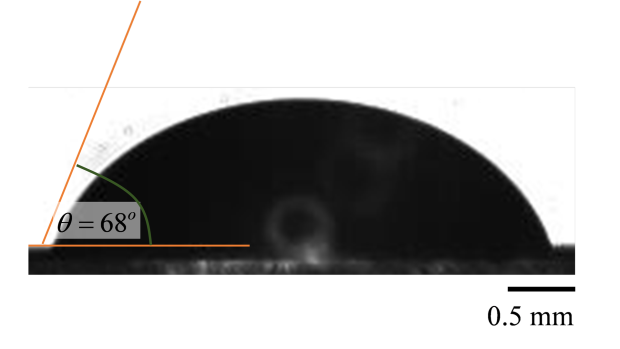
Bi-convex aspheric optical lenses / Prof. Animangsu Ghatak
One of the recent publications from the Mechanics of Soft Materials Lab at the Indian Institute of Technology, Kanpur, begins with a description of what trilobites are. Now, what has trilobites – sea creatures that became extinct even before the era of the Dinosaurs – got to do with the study of the physics of materials? Turns out, nature is indeed a wonderful place! Natural selection had, all those millions of years ago, perfected a unique visual system in these creatures, the lens shapes of which Prof. Animangsu Ghatak’s laboratory at IIT-Kanpur seems keen on reproducing.
Trilobite eyes, made of calcite (calcium carbonate) crystals, are not adjustable unlike our eye-lenses. It had been moulded into two particular shapes, that were deformed spheres. Mathematicians Huygens and Descartes showed in the 17th century that there exist only two shapes of a bi-convex lens which allow light rays from a point source to be focused onto a single point on the optical axis without aberration. Turns out, nature had endowed trilobites with these exact shapes of lens for their non-adjustable calcite eyes!
“We wanted to make spherical lenses which we required in our adhesion studies. However, the way we prepared the lenses, they turned out to be aspheric (not a part of a sphere). We then found out that nature had many examples of aspheric lenses like in the case of trilobites and these lenses exhibit superior optical performance. We wanted to make lenses having similar shapes and we came up with an idea for mimicking such shapes”, says Prof. Ghatak about the inspiration for the research.
These bio-inspired lenses find plentiful uses in areas ranging from microscopy and laser physics to optical metrology. This is because spherical aberration – the phenomenon where light rays entering from the periphery of a lens gets focused at a different point than the ones passing through the centre of the lens – is the main culprit in producing blurred images. To correct this, a complex optical system of many lenses is often used, making optical instruments complex and bulky. An alternative solution is to alter the curvature of the lens so as to focus the peripheral and central rays at the same point, i.e to use aspherical lenses.
The traditional top-down methods of lens fabrication like grinding or polishing the surface of a rigid material into the required shape becomes tricky when making aspheric lenses because of their spatially varying curvature. Prof. Ghatak’s lab has recently come up with a clever, yet simple, bottom-up approach for the fabrication of aspheric lenses.
In the fabrication method used, a pre-polymeric liquid (Polydimethylsiloxane) is dropped on to a heated substrate plate made of thin silicon wafers. The shape a liquid drop takes on a surface depends on both the forces of surface tension, as well as the affinity of the materials of the liquid and the surface (surface wettability). For example, on a glass surface, a water drop spreads to form a thin layer while a drop of mercury spreads minimally and remains almost spherical. In this fabrication method, while surface tension aids the liquid flow, cross linking (formation of cross links/bonds between the liquid molecules to form the polymer) due to the elevated temperature of the substrate works to arrest it, finally solidifying the liquid into a lens. The interplay of these competing forces determines the dynamics of the spreading and thus the eventual shape of the lens.
In a slightly modified method, the liquid is dropped on to a heated substrate with a small hole dug into its centre. This results into the liquid leaching through the hole and spreading unequally on the bottom surface (the pendant drop) along with the top surface (sessile drop) and finally solidifying into a lens with two convex surfaces at the bottom and at the top of the substrate, remarkably similar in shape to those found in trilobites. Gravity joins surface tension in assisting the liquid flow while, as in the previous case, crosslinking of the polymer arrests it.
By finely controlling the various parameters like hole diameter, substrate wettability, thickness and temperature, the researchers have produced a variety of non-spherical lens shapes including ones difficult to achieve using conventional methods. These lenses display large optical magnification with minimal spherical aberration and high optical resolution. The team has also demonstrated the application of these lenses by capturing magnified images of several microscopic objects.
“The novelty of our fabrication method is in simplicity and its low cost. We have filed for a patent and are now looking at some interesting applications. We have made a prototype of a portable, standalone, battery powered optical microscope that can be interfaced with a smart phone. We plan to make several additions to it like fluorescence microscopy”, says Prof. Ghatak about the future direction of this work. The fabrication method is easily scalable and the lenses reproducible, hinting at possible industry level applications in the future.
The research was funded by the Department of Science and Technology, Govt. of India and the results have been published as articles titled ‘Generation of Aspherical Optical Lenses via Arrested Spreading and Pinching of a Cross-Linkable Liquid’ in Langmuir (http://pubs.acs.org/doi/abs/10.1021/acs.langmuir.5b04631) and ‘Bi-convex aspheric optical lenses’ in Applied Physics Letters (http://aip.scitation.org/doi/abs/10.1063/1.4978353).






